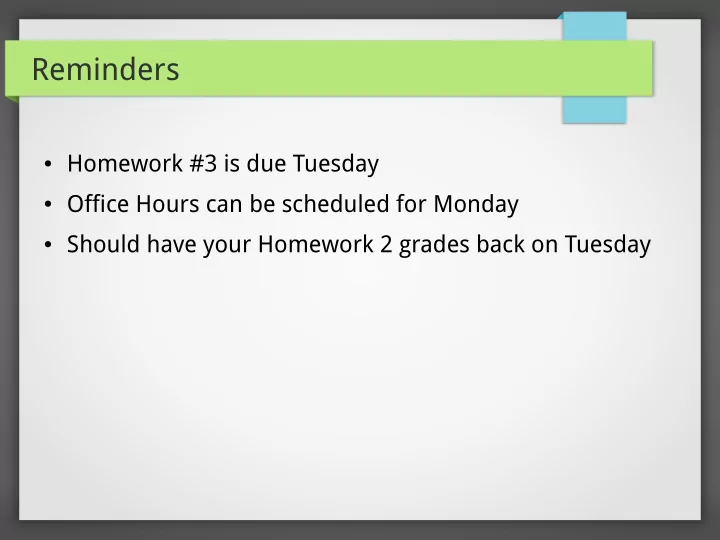

Reminders ● Homework #3 is due Tuesday ● Office Hours can be scheduled for Monday ● Should have your Homework 2 grades back on Tuesday
Practice ● Prove the sum of two odd integers is even. ● Prove every odd integer is the difference of two squares. ● Prove if n is an integer and n 3 +5 is odd, then n is even. ● Prove max( x , y ) + min( x , y ) = x + y ● Prove or disprove there is a rational number x and an irrational number y such that x^y is irrational ● Prove given real number x there exist unique numbers n and e such that x = n - e , n is an integer, and 0 <= e < 1
CMSC 203: Lecture 7 Sets and Functions
What is a set? ● Discrete structure (the first one we look at) ● Used to group objects together ( contain ) ● Usually, elements have similar properties ● Unordered ● Given element a , we say: – a ∈ A (a is an element in set A) – a ∉ A (a is not an element in set A )
Defining a Set ● List all elements using the roster method – {a, b, c, d} – {1, 2, 3, …, 100} ● Use set builder notation – O = { x | x is an odd positive integer less than 10} – O = { x ∈ Z + | x is odd and x < 10} – O = {x ∈ R | x = p/q, p ∈ Z + , q ∈ Z + }
Common Sets ● N = {0, 1, 2, 3, …}, set of natural numbers ● Z = {…, -2, -1, 0, 1, 2, …}, set of integers ● Z + = {1, 2, 3, …}, set of positive integers ● Q = {p/q | p ∈ Z , q ∈ Z , q ≠ 0}, set of rational numbers ● R , the set of real numbers ● R + , the set of positive real numbers ● C , the set of complex numbers
Equality ● Two sets are equal iff they have the same elements ● ∀ x(x ∈ A ⟷ x ∈ B) ● Denoted by A = B ● Examples: – {1, 3, 5} ≟ {3, 5, 1} – {1, 3, 3, 3, 5, 5, 5} ≟ {1, 3, 5}
Special Sets ● Set with no elements – Called either empty set or null set – Designated by ∅ or { } – Example: {x ∈ Z + | x > x 2 } = ∅ ● Set with one element – Called a singleton set ∅ ≠ { ∅ } – ● Set of all elements in (considered) universe – Called universal set – Designated by U
Naive Set Theory ● When Georg Cantor “invented” the notion of sets (in 1895) he defined it as a collection of objects ● Leads to notion that any property contains a set of exactly the properties – This leads to paradoxes (logical inconsistencies) – S = {x | x ∉ x} leads to S ∈ S ⟷ S ∉ S ● We will still use Naive Set Theory because it's easy and works in many cases
Venn Diagrams U a u V e o i
Subsets ● Set A is a subset of B if and only if every element of A is an element of B – ∀ x(x ∈ A → x ∈ B) – Denoted by A ⊆ B ● Two ways to prove – Show that if x belongs to A then x also belongs to B ● This proves A ⊆ B – Find a single x ∈ A such that x ∉ B ● This proves A ⊈ B
Examples ● {x | x is odd and x < 10} ⊆ {0, 1, 2, …, 9} ● Z ⊆ R ● Z + ⊆ Z ● N ⊆ Z + ∅ ⊆ S where S is an arbitrary set ● ● S ⊆ S
Size of Sets ● If n distinct elements in set S, S is a finite set with cardinality n – Cardinality is denoted by |S| – Cardinality is the “size” if there are no duplicates ● If a set is not finite, it is infinite
Set Operations ● Union: A ⋃ B – set of all elements in A or B ● Intersection: A ⋂ B – set all all elements in A and B – Disjoint if A ⋂ B = ∅ ● Difference: A – B – set of elements in A but not in B ● Complement : A – set of all elements in U but not in A
Sample Sets ● Let A be the set of students who live within one mile of school and let B be the set of students who walk to classes. Describe the students in the following sets: – A ⋂ B – A ⋃ B – A – B – B – A
Recommend
More recommend